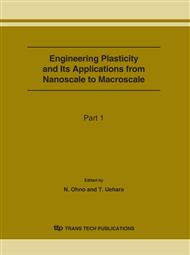p.913
p.919
p.925
p.931
p.937
p.943
p.949
p.955
p.961
Grain Refinement and Strengthening of a Cylindrical Pure-Aluminum Specimen by Using Modified Equal-Channel Angular Pressing Technique
Abstract:
A new grain refinement and strengthening technique by modified ECAP (equal-channel angular pressing) technique was proposed in this study. ECAP technique is an effective technique for grain refinement and strengthening of metal material. This technique gives high shear plastic strain to the material without geometric transformation of the specimen. However, traditional ECAP technique is restricted by material type and size, especially length. Such kinds of restrictions cause various problems in practical use. We modified traditional ECAP dies and processes to allow high plastic strain for long-length pure-aluminum specimens. Then, grain distribution was observed using a microscope, grain size was determined by the Jeffries and the Heyn methods, and strengthening was investigated by micro-Vickers hardness test. Then the effectiveness of proposed grain refinement or strengthening techniques was discussed.
Info:
Periodical:
Pages:
937-942
Citation:
Online since:
June 2007
Authors:
Price:
Сopyright:
© 2007 Trans Tech Publications Ltd. All Rights Reserved
Share:
Citation:


